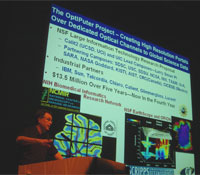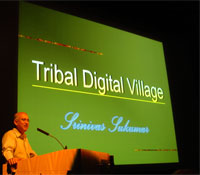SDSC and Calit2 Host Minority-Serving Institutions Cyberinfrastructure Institute
San Diego, California, July 5, 2006 -- The national community of Minority-Serving Institutions (MSIs) was represented by 36 representatives from more than 30 institutions at a five-day workshop completed last week in San Diego to learn about cyberinfrastructure (CI) and explore possible collaborations with CI leaders. The meeting consisted of plenary presentations by e-scientists and CI practitioners, hands-on work with e-science tools, seminars, and birds-of-a-feather discussions -- all for attendees to meet members of the CI research community and explore partnering opportunities to put new-found knowledge immediately to practical use.
The PI on the institute grant is Geoffrey Fox, professor of Informatics, Indiana University, and long-time technology education advocate (see Q&A with him at end of this article).
“The San Diego Supercomputer Center (SDSC) has been working closely with the Alliance for Equity in Higher Education to create a professional development program that would result in immediate and significant increases in MSI involvement in cyberinfrastructure at several levels,” said SDSC Education Director Diane Baxter, one of the organizers of the institute.
Calit2 hosted the group Wednesday morning with presentations on Calit2’s cyberinfrastructure, educational programs, and the Tribal Digital Village (TDV) project by Larry Smarr, Jerry Sheehan, and Sukumar Srinivas, respectively. These presentations were followed by a tour of Calit2’s digital cinema theater and the opportunity to experience super-high-definition 100-million-pixel projection (courtesy of the first Sony 4K projection system installed in the United States), and an immersive visualization environments.
|
||||
“Calit2 is committed to working with the MSIs to ensure they are involved right from the beginning with cyberinfrastructure,” said Calit2 director Larry Smarr. “Together with SDSC, we have a unique opportunity to partner with MSIs to lower the digital divide.”
“Our involvement,” said Jerry Sheehan, who oversees government program development for the UCSD division and supports Calit2 educational programs, “builds on emerging Calit2 outreach efforts at the undergraduate and K-12 levels. Our campus programs have been very successful and, through venues like this institute, we’re looking to extend them beyond those bounds to engage more broadly with the national community.”
The TDV project, described during the group’s visit to Calit2, is using media to understand Indian tribal communities and support projects that are important to them. Sukumar Srinivas said, “Our approach to working with communities is to spend time understanding that community’s values and way of doing things, so we can introduce targeted technologies that are culturally and socially acceptable to them and, hence, more likely to be adopted. So one of our goals is to integrate social sciences more tightly into Calit2.”
The first day of the institute provided an overview of CI, including such technical aspects as the TeraGrid and National LambdaRail, providing the necessary arguments to enable colleges and universities to make a strong commitment to integrating CI resources into campus research and educational programs.
“The MSI Cyberinfrastructure Institute is a national collaboration working to maximize research and education opportunities for faculty, staff, and students to apply cyberinfrastructure in the pursuit of scientific discovery,” said Scott Lathrop, TeraGrid director of Education, Outreach and Training and, previously, long-time education leader at NCSA. “The TeraGrid team is committed to working with this group and collaborators to enhance the human and technological capacity among MSIs by addressing their needs for access to the resources and services offered by TeraGrid.”
The program provided three professional development tracks -- for domain/general science faculty interested in research, computer science faculty and staff interested in research, and those interested in integrating CI into their curricula.
The domain science faculty track provided an introduction to e-science tools and methods. The computer science track provided computer science faculty and IT technical staff an introduction to the design and development of e-science tools and services. The curriculum track presented ways of, and challenges to, bringing CI into teaching and learning.
Additionally, participants were asked to give short talks about research, curriculum, and institutional issues important to them and their home institutions to facilitate the process of matchmaking among the attendees and speakers.
This event was a joint project of the Alliance for Equity in Higher Education (AIHEC, HACU, and NAFEO), SDSC, and the Pervasive Computing Labs at Indiana University . It was organized by Geoffrey Fox, Alex Ramirez, Diane Baxter, and other members of the MSICII committee. Portions of the meeting were also presented over the Access Grid for those with such systems that weren’t able to attend. Plenary sessions were recorded for live webcasting and archived, on-demand viewing on the CI Channel. Interested viewers will be able to see them by mid-July at http://www.cichannel.org.
“We look forward to nurturing the scientific and educational collaborations been launched through this program,” said Baxter. “SDSC will continue to be an active partner in effective programs that broaden participation in science and technology by all members of our diverse society. Solutions to future challenges will demand the creativity of all our country’s brightest minds. MSIs will play leadership roles in preparing the next generation’s innovators and problem-solvers.”
Q&A with Geoffrey Fox, Indiana University
What is your involvement with planning/spearheading this event? I am the PI of the Minority Serving Institutions Cyberinfrastructure Institute. I do this with the courtesy title of Visiting Scholar for Cyberinfrastructure Development at the "Alliance for Equity in Cyberinfrastructure." The Alliance represents the three major MSI Higher Education Organizations (AIHEC, HACU, and NAFEO), which together encompass 335 MSIs for American Indian, Hispanic, and Historically Black Colleges and Universities institutions. We aim to be an MSI-led activity that links MSIs systemically with leaders in CI, like Calit2 and SDSC.
What do you expect the outcome(s) of the institute to be? Next steps?
We are at the initial stages of identifying the opportunities and challenges to integrating
CI into MSI research and education. We have identified several action items, such as integrating the MSIs with the TeraGrid and onto the National LambdaRail [NLR]. I think we also have consensus on our role as the organization that links MSIs and CI opportunities, as opposed to the organization that implements MSI involvement with CI – this is an important distinction.
What do you see as the main challenges to MSI institutions/faculty/students making better use of CI?
MSIs at the level of president/deans are unaware of the importance of CI and
how to take advantage of it. Faculty and students are not naturally involved in major CI projects and lack expertise, release time, and funding. Often institutions do not have the needed infrastructure and/or staff to support it. For example, the current TeraGrid software stack requires 5-10 people per institution to support local deployment. This implies MSIs cannot easily become full TeraGrid partners. We need to lower this barrier.
What is your advice to Calit2 to help address these challenges?
We should work with Calit2 to identify science projects that Calit2 is involved with that appeal to MSIs based on their science research interests. We need to work with MSIs -- faculty, administration, and infrastructure people -- to get them the necessary training, funds, and infrastructure to enable their NLR/Calit2 involvement.
How do MSIs’ needs compare with those at other institutions where you’ve worked (Syracuse, Indiana )?
Syracuse and Indiana have the needed infrastructure, some faculty already involved with CI, and administrations that understand what research excellence requires so they can expand their CI involvement as appropriate without special external help.
How have you seen technology adoption change over time? What technologies have been successful and why? Are there some that seemed well conceived but never “caught on”? What are your ideas on why that might have been?
As Larry Smarr says, “technology is changing as rapidly as it ever has.” Technologies that are disruptive, that is, that provide major advantages somewhere but not necessarily everywhere and that are simple are the ones that succeed. Ideas catch on when they come at the right time – if too early or too late, they lead to failure.
What other issues do you think need to be addressed?
I have been impressed by the interest in helping MSIs from Calit2, SDSC, NCSA, and the TeraGrid community. We need to see how to take advantage of this interest. This requires working with MSIs and funding agencies to implement MSI-CI linkage. I think we need new funding models.
Article by Stephanie Sides; photos by Barbara Haynor
Media Contacts
Stephanie Sides, ssides@ucsd.edu, 858-534-5131



